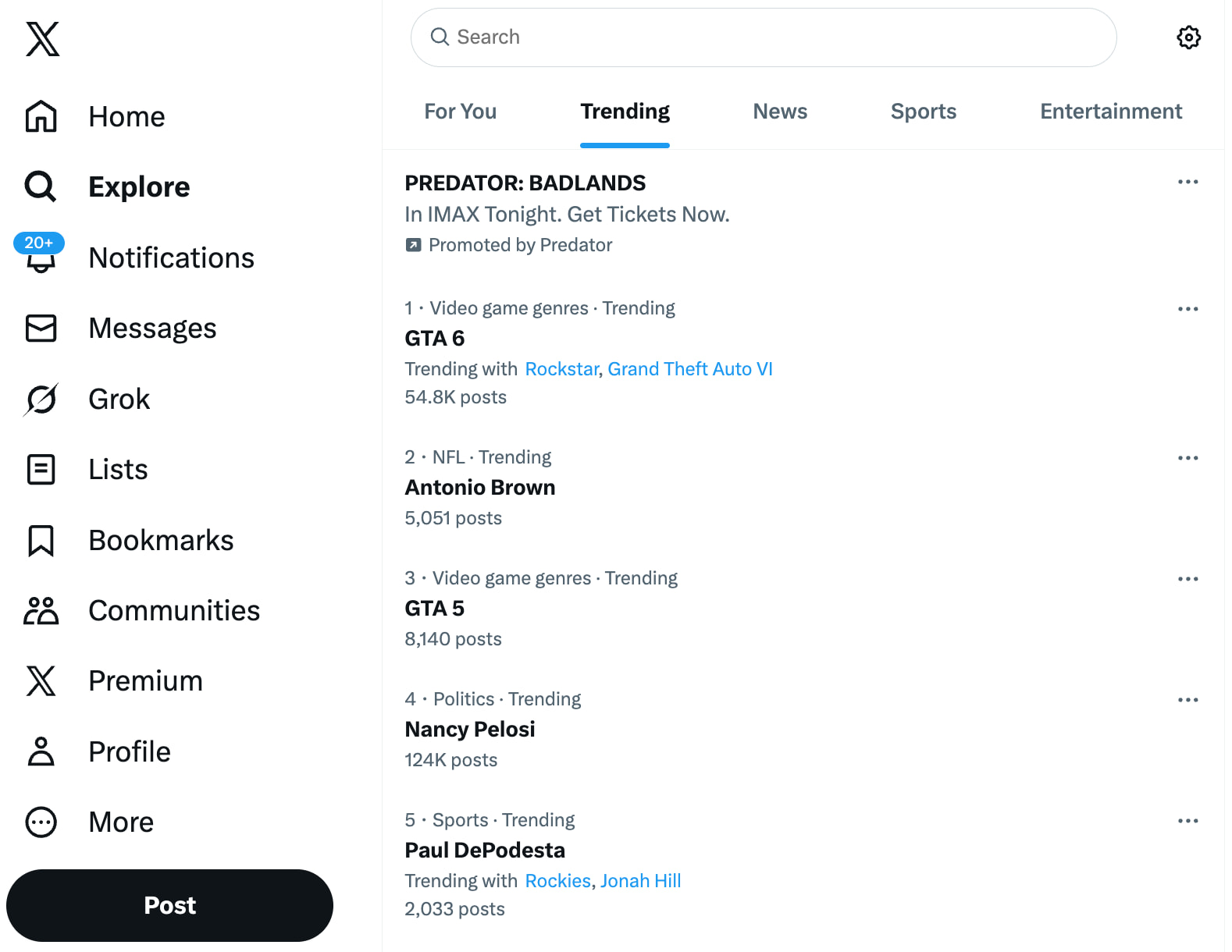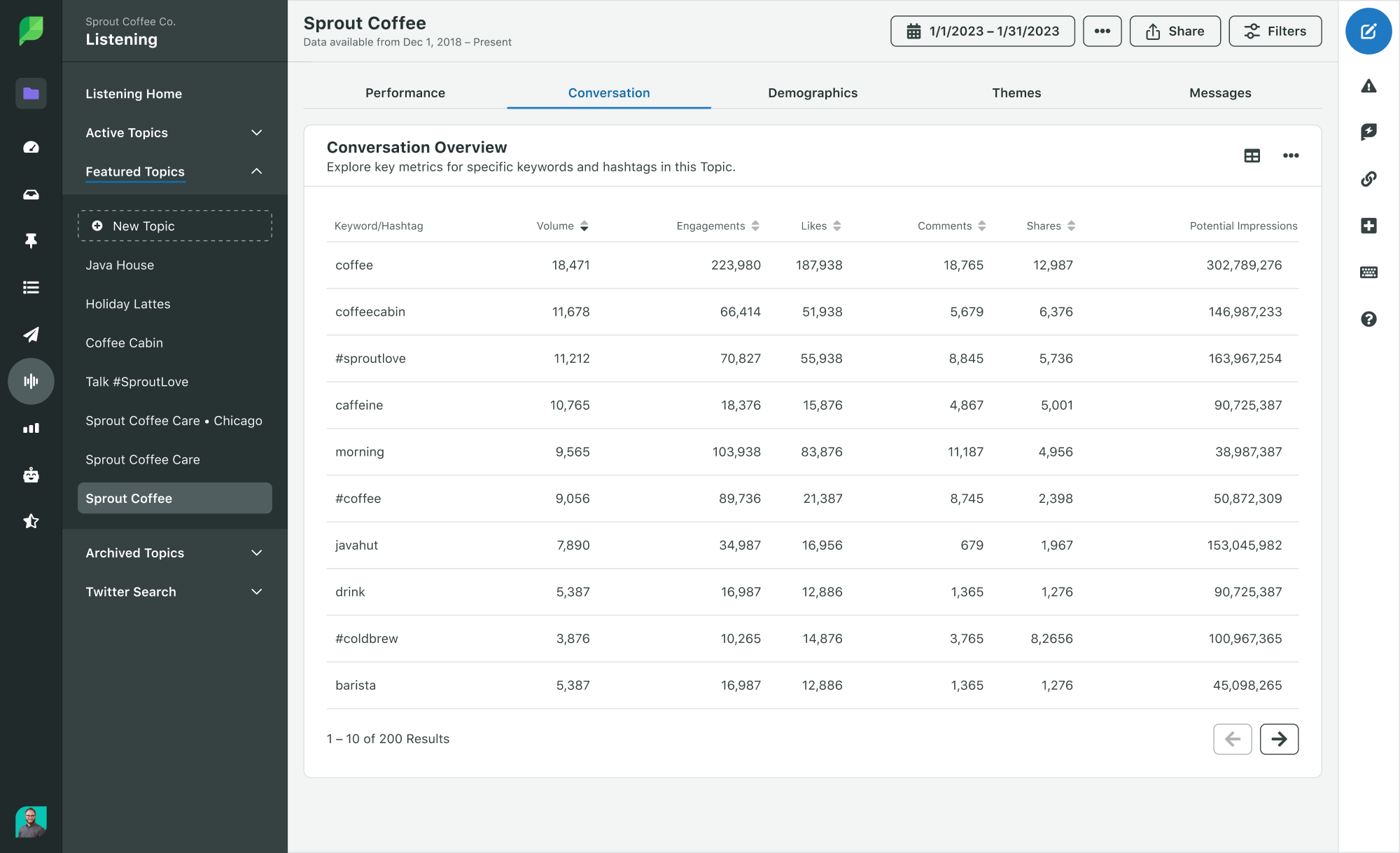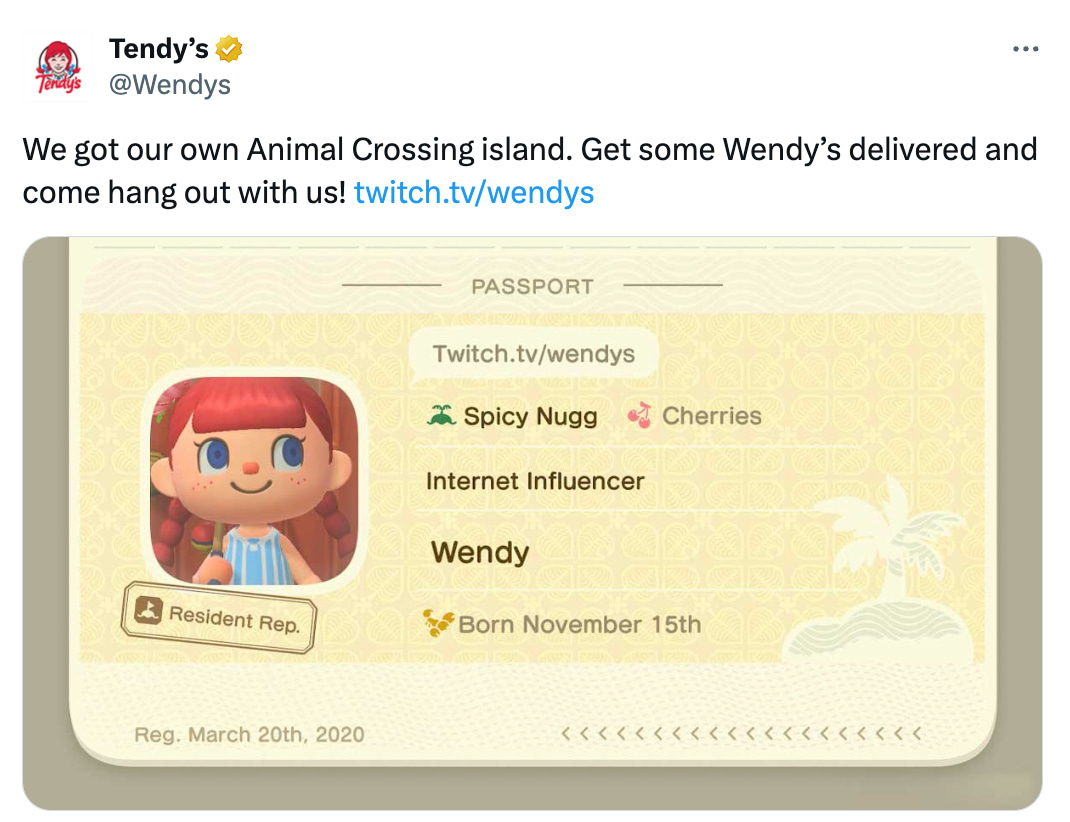How to use Twitter hashtags: Find trending X hashtags [2025]
Table of Contents
In today’s competitive social media landscape, posting on each platform isn’t enough. Along with a comprehensive social media strategy, you also need a sophisticated hashtag strategy to reach a wider audience. If you’re not using X (formerly Twitter) hashtags to their fullest, you’re missing out on impressions and engagement.
This guide will explain how and why X hashtags matter for your brand, how to find popular and relevant hashtags and when to use them for marketing. Let’s get started.
What are hashtags and why are Twitter (X) hashtags important?
Hashtags are keywords or phrases preceded by the # symbol that categorize content and make it discoverable to targeted audiences on X. They expand your reach beyond followers, connect you to trending conversations and support customers in finding your brand when they search specific topics.
When someone clicks on or searches for a specific hashtag, they’ll be able to find all the profiles and public posts that use that hashtag. For example, if I search for #AFROTECH2024, I can see plenty of posts from the conference.

X hashtags expand your reach, putting your brand in front of potential customers and followers who are actively seeking conversations around the topic. By using hashtags to join in on subjects like industry discussions or X trends, you can become visible to a wider audience outside your following and boost the discoverability and reach of your content.
What are Twitter (X) trending hashtags?
Engaging with trending X hashtags helps you attract a highly relevant audience that’s interested in what you have to say. Some might discover your products through these hashtags, while others might start following your brand.
What does it mean for a X hashtag to become “trending?” Find Twitter (X) trends on the “What’s happening” sidebar on desktop or the search tab on mobile, which show topics picking up momentum and driving conversations on X. These topics, news stories and popular hashtags are selected based on global trends, regional ones or related by the Twitter (X) algorithm to an individual’s own interests, depending on user settings.
One reliable source of X hashtag ideas are the regularly occurring hashtag holidays that frequently rank as a Trending Topic. We’ve created a full yearly calendar of hashtag holidays you can easily slot them into your publishing plans.
Beyond these more predictable top hashtags, X trends emerge rapidly around the day’s news, events and even memes that unexpectedly gain viral traction.
While it’s okay to join popular hashtags and conversations, make sure you know what a hashtag means and if it’s relevant to your brand before posting. Before using a trending hashtag, ensure it’s relevant to your content and target audience without the risk of appearing opportunistic or out of touch.
Using hashtag research tools can help you efficiently and effectively incorporate hashtags into your upcoming content–read on for ways to find top X hashtags.
3 ways to find trending Twitter (X) hashtags
Besides knowing when to use X hashtags, you need to find out which hashtags are popular. One way to do that is with a hashtag tracking tool like you can with Sprout Listening, but here are three other ways to find valuable X hashtags:
1. Twitter (X) Trending and Explore tabs
X comes with a native search feature that lets you keep up with the latest hashtags. From your X dashboard, click on the #Explore tab. Then select the Trending tab to get a list of the topics and hashtags currently trending in your region.

Find a list of popular topics and hashtags personalized according to your interests or business. Since these are the top trends for a wide audience, it can be hard to focus on the specifics that your brand’s audience may be interested in. That’s where a more powerful X hashtag tracking tool comes in.
2. Sprout Social Social Listening
To create a more relevant list of important X hashtags for your brand, make the most of Sprout Social’s Listening tools. Social listening tools are a superpower that lets you monitor specific keywords, hashtags and even competitor mentions. By tracking these conversations, you gain invaluable insights into what your target audience is discussing, the hashtags they’re using and the trending topics that resonate with them.
This real-time data lets you identify relevant hashtags organically woven into conversations, ensuring your content aligns with current trends and interests.

With Sprout Social’s robust analytics, you go beyond identifying X hashtags. Analyze hashtag performance by tagging them as part of a campaign, track engagement metrics and understand how specific hashtags contribute to your overall social media goals. This data-driven approach allows you to refine your hashtag strategy and ensures you’re identifying the most important hashtags and maximizing your social media ROI.
Conducting this research doesn’t have to take a lot of time. Check out our list of 40 ways to use social listening for inspiration on targeted, efficient ways to start using these powerful insights.
3. Use a Twitter (X) hashtag generator
X hashtag generators can be valuable tools for brands looking for hashtag inspiration. These tools help identify new and relevant hashtags, expand brainstorming and refine hashtag lists.
While generators offer time-saving benefits, brands should use them strategically and not rely on their suggestions completely. It’s important to evaluate the relevance of the suggested hashtags and ensure they align with your brand’s voice and content. By combining hashtag generators with manual research, trend analysis and audience insights, brands can strategically optimize their hashtag use, expand their reach and generate engaging conversations on X.
Top 30 trending hashtags on Twitter (X) for businesses
It’s tough to guarantee these will be the top-trending hashtags for X when you read this list in the future. At the time of writing, these are the most popular hashtags for B2B businesses to use on X.
- #marketing
- #digitalmarketing
- #socialmedia
- #business
- #entrepreneur
- #smallbusiness
- #contentmarketing
- #SEO
- #innovation
- #technology
- #leadership
- #sales
- #branding
- #customer
- #customerservice
- #ecommerce
- #retail
- #growth
- #productivity
- #businessgrowth
- #businesstips
- #businessowner
- #womeninbusiness
- #futureofwork
- #remotework
- #sustainability
- #ai
- #web3
- #metaverse
- #NFT
How many hashtags should you use on Twitter (X)
As a starting rule, us 1-2 hashtags per X post for maximum impact and to preserve clarity. Test what works best for your brand’s X posts as you go. But, overall, it’s safe to say that fewer hashtags is better.
With only 280-characters on a X post (unless you have X Premium, you can use up to 25,000 characters), every character is valuable. Cluttering your post with hashtags fills space and tightens the opportunity to be engaging to your audience.
Dos and don’ts of using Twitter (X) hashtags
Research before you hashtag. The most effective strategies start with analyzing Twitter (X) followers to understand their interests and what resonates with them.
Using hashtags without research leads to social media disasters and damage control.
Here are some quick do’s and don’t tips when using hashtags on any platform, but especially X:
- Do a real-time check: X moves fast! Don’t only rely on any list (even this one). Always glance at Twitter Trending Topics page to catch anything super hot right now. This makes sure you’re tapping into current conversations.
- Do use relevant hashtags: A hashtag might be popular, but don’t blindly use these. If it doesn’t fit your content or your brand, it will look spammy and confuse users. Before using a hashtag, ask if it relates to your content, audience interest and brand.
- Do mix up the types of hashtags: Don’t just use super broad hashtags (#business) or super niche ones (#socialmediamarketingforstartups). A mix is best. This lets you reach a wider audience while also targeting those with specific interests, increasing your chances of connection.
- Don‘t overuse hashtags: A few strong hashtags are better than a huge, irrelevant list. Focus on a few strong ones. Think quality over quantity. Each hashtag should add value; don’t throw several in your content to see what sticks.
- Do track what works: See which of these (or others you find) get you the most engagement to refine your strategy. Pay attention to which hashtags get you the most engagement. This tells you what resonates with your audience, letting you refine your strategy over time and a good tool to analyze Twitter (X) data can greatly assist in this tracking.
How to use trending Twitter (X) hashtags for your brand [+ examples]
The key to X hashtags is to use them correctly rather than just blindly using them and hoping for the best. This is especially true for those running brand social media accounts, as it requires taking a calculated approach to proper hashtag marketing.
Check out when you should use X hashtags for your brand:
1. Post about events and conferences
Make the most of X hashtags to join in on conversations around popular events (#Oscars) and industry conferences (#SocialMediaWeek). Better yet if your brand is making an appearance or a relevant contribution to an event, you can use these hashtags to share news about your participation.
See how the American Music Awards uses the #AMAs50 hashtag in the following post to create a discussion around the event.

2. Celebrate holidays and notable days
Use X hashtags when celebrating a national (#Thanksgiving) or global holiday (#EarthDay) with your community. In addition to important holidays, join in on the fun with lesser-known celebrations such as National Pancake Day or National Emoji Day. Be sure to make the most of celebrations that are highly relevant to your product.
For example, see how Good Morning America posted about #NationalBurgerDay.

3. Promote brand campaigns
The best time to use X hashtags is when you’re promoting your brand and its products. This could be through a hashtag for a certain marketing campaign or even a hashtag for the product itself. You can also create a branded hashtag campaign to collect user-generated content and drive even more visibility around your brand.
For example, Social Media Examiner uses the #SMMW25 hashtag to promote Social Media Marketing World Conference.

4. Connect with pop culture trends
X is a conversation hub, especially on pop culture topics. So if you decide to join in on those conversations, using a relevant hashtag for the topic supports your X post in getting some visibility.
See for example how the official Wendy’s X uses the Animal Crossing: New Horizons hashtag #ACNH in the following post.

Keep in mind that your brand doesn’t need to get involved in every pop culture topic. Social media crises can happen even when you think your X post was on par with the topic. Make sure you understand the topic before you post.
5. Join a weekly trend or challenge
A lot of the major X hashtags involve weekly challenges and trends, such as #ThrowbackThursday, #MondayMotivation, etc. So if you ever decide to join in on these challenges, don’t forget to make use of the relevant hashtags.
Check out Sanrio posting something for #MondayMotivation. It’s simple and uses imagery that aligns with their brand voice.

6. Support a cause
In an era of socially conscious consumers, brands that authentically support causes build stronger connections with their audiences. When showing support for a cause, use hashtags to amplify your message and reach like-minded communities.
Ben & Jerry’s has been exemplary in this aspect, as covered in our recent Social Spotlight. See how they used #ClimateWeek in the X post below, for example.

7. Join the discussion on relevant topics
Even when you post about general interest topics (#nature, #marketing, etc.), including a relevant hashtag will help you gain more visibility among an interested audience.
See the hashtags like #ethicalfashion and #sustainablefashion in the following post from the UK brand Baukjen, for example. By using those general interest topics, they’ve expanded their audience beyond their local market.

Measuring hashtag performance with social media analytics
You can’t improve what you don’t measure. Tracking your hashtag performance is the only way to move from guessing to knowing what drives results. It’s how you turn a good hashtag strategy into a great one.
The right data reveals which hashtags expand your reach, which drive engagement and which connect you to valuable new audiences. This isn’t just about vanity metrics; it’s about understanding the direct line between a hashtag and your business goals.
Track these essential hashtag performance metrics:
- Reach expansion: How many new users discovered your content through hashtags
- Engagement rates: Likes, shares and comments on hashtagged posts vs. non-hashtagged content
- Click-through rates: Traffic driven from hashtagged posts to your website
- Follower acquisition: New followers gained from hashtag-driven content
- Brand mention growth: Increase in organic brand mentions after hashtag campaigns
Sprout Social’s comprehensive analytics tools give you this clarity. Our reports show you exactly how your hashtags perform, tracking metrics like impressions, engagements and link clicks. With our Tag Report, you can analyze hashtag effectiveness across individual posts or entire campaigns. This empowers you to make data-driven decisions, refine your strategy in real time and prove the ROI of your efforts to leadership.
Twitter (X) hashtags for your marketing strategy
Effectively using X hashtags frequently comes down to striking a balance between original branded hashtags and joining the conversation on relevant hashtags. This gives you options in your publishing strategy and content planning: find a balance between planning content around a campaign hashtag and gaining visibility through trending X hashtags.
Either way, hashtags are a powerful avenue to brand recognition and success. Have you noticed how fast food brands like Wendy’s created their own hashtags and made them go viral on X? The brand used their #WendysBreakfastBattle hashtag to post scorching roasts about its competitors. Use our Twitter (X) marketing strategy guide to help shape your X strategy and inspire your next campaign.
Start using Twitter (X) hashtags strategically for your brand
Hashtags aren’t just a feature—they’re a strategic tool for growth. When used with precision, they amplify your voice, connect you with your audience and drive real business impact. You’re no longer just posting into the void; you’re actively shaping and joining conversations that matter.
The difference between managing social and leading on social is strategy. It’s time to stop guessing and start building a data-driven hashtag approach that delivers results. With the right insights and workflows, you can transform your X presence from reactive to revolutionary.
Ready to transform your hashtag strategy from guesswork to precision? Sprout Social’s comprehensive analytics, social listening tools and smart publishing features give you everything you need to identify winning hashtags, track their performance and optimize your strategy in real-time. Start your free trial and see how data-driven hashtag strategies drive real business results.
Twitter (X) hashtags FAQs
What are good hashtags for Twitter (X)?
Good hashtags are relevant to your content, brand and audience. Use a mix of industry tags (#Marketing), niche topics (#ContentStrategy), trending events (#SocialMediaWeek) and branded hashtags (#SproutSocial).
Are hashtags effective on Twitter (X)?
Yes, hashtags are highly effective on X when used strategically. They increase the discoverability of your content, connect your posts to relevant conversations, expand your reach beyond your followers and help you find new audiences interested in your brand.
How often do Twitter (X) trending hashtags change?
X trends are dynamic and change rapidly, often multiple times throughout the day. They’re influenced by real-time events, breaking news and viral conversations. That’s why it’s critical to check what’s trending right before you post.
How do hashtags grow Twitter (X) followers?
Absolutely. By using relevant hashtags, you expose your content to users who are interested in those topics but don’t follow you yet. If they find your content valuable, they’re much more likely to follow your account to see more of it.
Should I create branded hashtags for my business?
Creating a branded hashtag is a powerful move for building community and tracking conversations specific to your brand. Use it for campaigns, events or to collect user-generated content. A unique, memorable branded hashtag makes it easy for your audience to find and engage with you.

Share